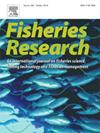Growth rate extremes of a Sciaenid in an ocean-warming hotspot
IF 2.3
2区 农林科学
Q2 FISHERIES
引用次数: 0
Abstract
Argyrosomus inodorus is a cool water Sciaenid, important to the recreational and commercial coastal fishery in Namibia, the northern Benguela. Given recent findings on the northern Benguela as an ocean-warming hotspot and A. inodorus being more sensitive to warm temperatures than its congeneric A. coronus, it is important to study long-term growth responses of this Sciaenid. We developed a 34-year otolith biochronology for A. inodorus. The linear mixed-effects models fitted to A. inodorus’ otolith biochronology indicated that the best linear unbiased predictor of growth was significantly positively correlated with mean sea surface temperatures (SSTs) in September of the year of formation and significantly negatively correlated with mean summer SSTs (November y-1), in the central Namibian area (20–24◦S, 12–14◦E). Thus, faster annual growth was observed during warmer winter/spring temperatures (up to 16℃) and slower growth was noted during warmer summer temperatures (> 16℃). These results indicate that the species has a narrow range of thermal plasticity, and highlight the recent reductions in growth of this species in response to rapid thermal change observed in the ocean warming hotspot. Our findings suggest that A. inodorus would not be able to adapt readily with future climate warming predicted to happen and already happening along the northernmost part of the Namibian coast.
海洋变暖热点地区一种笛鲷的极端生长率
inodorus Argyrosomus inodorus是一种冷水鱼,对纳米比亚北部本格拉的娱乐和商业沿海渔业很重要。鉴于近年来本格拉北部作为海洋变暖热点的研究发现,以及A. inodorus比其同属A. coronus对温暖温度更敏感,研究该海螺的长期生长响应具有重要意义。我们建立了一套长达34年的臭虫耳石生物年代学。拟合的线性混合效应模型表明,在纳米比亚中部地区(20-24◦S, 12-14◦E),生长的最佳线性无偏预测因子与形成当年9月的平均海温(SSTs)呈显著正相关,与夏季平均海温(11月1 -1)呈显著负相关。因此,在暖冬/春期间(最高达16℃),年生长速度较快,而在暖夏期间(>;16℃)。这些结果表明,该物种具有狭窄的热塑性范围,并突出了近年来该物种对海洋变暖热点观测到的快速热变化的响应。我们的研究结果表明,随着纳米比亚海岸最北端即将发生和已经发生的气候变暖,A. inodorus将无法迅速适应。
本文章由计算机程序翻译,如有差异,请以英文原文为准。
求助全文
约1分钟内获得全文
求助全文
来源期刊

Fisheries Research
农林科学-渔业
CiteScore
4.50
自引率
16.70%
发文量
294
审稿时长
15 weeks
期刊介绍:
This journal provides an international forum for the publication of papers in the areas of fisheries science, fishing technology, fisheries management and relevant socio-economics. The scope covers fisheries in salt, brackish and freshwater systems, and all aspects of associated ecology, environmental aspects of fisheries, and economics. Both theoretical and practical papers are acceptable, including laboratory and field experimental studies relevant to fisheries. Papers on the conservation of exploitable living resources are welcome. Review and Viewpoint articles are also published. As the specified areas inevitably impinge on and interrelate with each other, the approach of the journal is multidisciplinary, and authors are encouraged to emphasise the relevance of their own work to that of other disciplines. The journal is intended for fisheries scientists, biological oceanographers, gear technologists, economists, managers, administrators, policy makers and legislators.
 求助内容:
求助内容: 应助结果提醒方式:
应助结果提醒方式:


